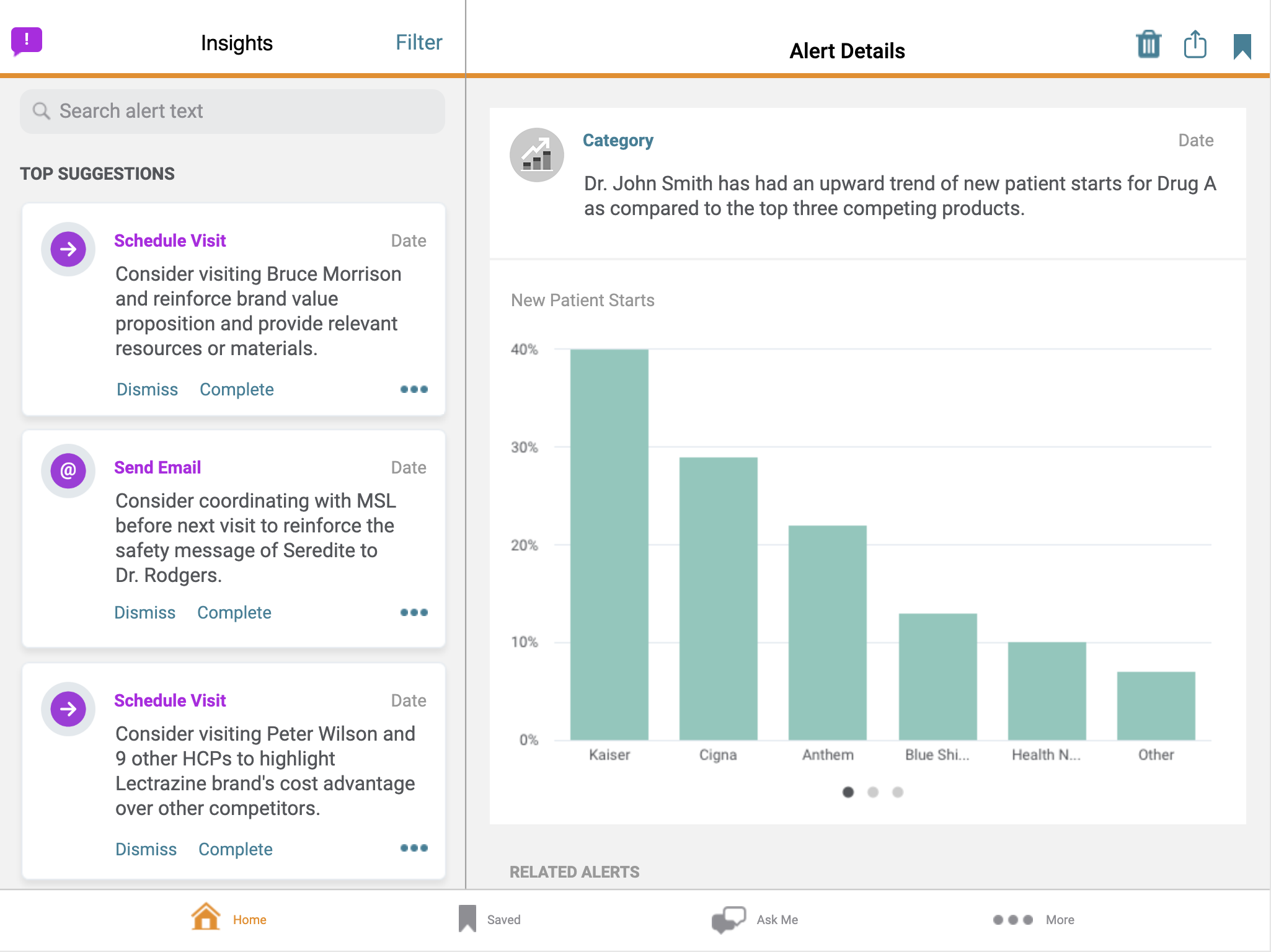Background
Research + Synthesis
ZS Associates had developed an ML algorithm that could identify trends and generate natural language insights and suggestions based on provider and pharmaceutical product data. Leadership had the idea of creating productizing this algorithm to feed these insights and suggestions to our clients and empower their sales force.
Eager to get into the front line sales force market, leadership created the Personalized Analytics product team to figure out how these insights and suggestions should be delivered to a pharmaceutical sales rep in a product experience.
Users
Pharmaceutical Sales Reps: Over the course of 2 months, I assisted the research team in conducting 20 interviews and combed through data from prior ZS projects to a total of 97 different reps across 17 different companies.
We gained a better understanding of how they went about their workday, identifying “targets” or health care providers, scheduling appointments with said providers, and the actual discussion and sales pitch to providers.
Additional behaviors such as scheduling being done at the home office, most of their day being spent on the road going from appointment to appointment, the events leading up to engagement, and the nature of the engagement itself also played a large role in shaping the design and form factor of the product.
User goals = Help me increase my product TRx and enrollments
Problems / Themes
After weeks of workshops, whiteboarding, and synthesis sessions, we were able to distill the following themes:
Weekly Planning: Out of the 100’s of providers in my territory, who are the most important?
Pre-Call Planning: Who am I visiting today? What am I going to talk about?
Performance tracking: How am I doing? Am I on track to meet my quotas?
These were determined due to their frequency and impact on rep success.
Rules and regulations around provider data and interactions were also a determining factor. This meant features such as call recording, note taking, and sales attribution were not in scope.
With a wealth of data and research insights, I collaborated with the research team to create a sales rep persona to ground our thinking, and also translated the findings to slide format to be presented to cross functional stakeholders.
Architecture
We wanted to ensure the main user goal of increasing sales and ZS’s goal of showcasing the insight and suggestion engine capabilities were aligned, while also providing an intuitive and comfortable experience.
The insight and suggestion engine would aid with weekly planning, helping reps identify high priority or “hidden gem” customers based on their prescribing behavior or similarity to frequently visited customers.
To facilitate pre-call planning, we needed to create provider profiles, and if possible, a scheduler.
Data such as provider metrics, activity, payer, and formulary status were at our disposal and would provide talking points and additional context for reps going on their provider visits. Profiles would allow reps to easily pull up relevant information as they head into their appointments.Performance tracking would be displayed with a territory overview dashboard. Reps would previously have to comb through multiple tools for this information, but would now have the ability to see it all in one place.
The ability to personalize the newsfeed, filtering out less relevant insights or prioritize specific providers and trends.
The “on the road” nature of a sales rep meant that it needed to be a mobile app, able to travel with them across their territory.
Once we aligned on how the product would function, I created a concept and site map with the help of our Lead UX designer.
Design + Launch
The team started out with low fidelity wireframing and prototyping, testing internally and presenting to leadership and stakeholders along the way to make sure the design was mapping to our vision and requirements. We went through several iterations and full scale prototypes before aligning on an MVP experience.
The direction that was settled on was to start simple for the MVP and eventually scale up to more complex and detailed integrations.
The Planning aspect was tabled for a later version, but the core value of an insight and suggestion feed was to be delivered.
Once we gained stakeholder alignment on our designs, we moved forward with high fidelity design and developer handoff. I collaborated closely with our development and QA team, validating their output, testing in our demo environments, and signing off on readiness.
The App:
Responsive across iOS devices, phone and tablet.
Design language and layouts consistent with then-modern app expectations.
Templatized layouts capable of displaying differing formats of client data.
Leverages a ZS design system, based off iOS native components.
Built in close partnership with in-house technical team.
Outcome: Delivery of a fully functional market ready app that satisfies our initial product vision
ML Driven Insights and Suggestions: App can generate actionable insights and suggestions in a natural language format, surfaced on a newsfeed.
HCP Profiles with Metrics and Activity: Reps can access profiles for any HCP in their territory to facilitate interaction and discussion.
Categorized Personalization: Reps can prioritize insight and suggestion categories, giving them control of the content of their newsfeed.
Territory Performance: Reps can see their product TRx, Enrollments, and Call Plan Attainment all in one place.
Epilogue
Personalized Analytics would eventually be rebranded and revamped to VERSO, then renamed again to today’s ZAIDYN Field Insights.
The rebrand to VERSO would include a large scale UI revamp and feature update led by me.
We would create a React/Android version of Field Insights called MyInsights, capable of coexisting in the Veeva CRM.
Our product team would win 2 awards (Best Software Development Product Team in 2023, ZS Impact in 2024)
As of 2024, we have onboarded for 12 large scale clients with an estimated ~10,000 users.




















